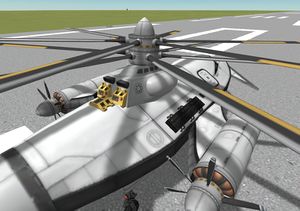Difference between revisions of "Breaking Ground Stock Craft"
AnalogFoxes (talk | contribs) m (→Arrow-E) |
AnalogFoxes (talk | contribs) m (Breaking Ground dependency tag) |
||
| Line 1: | Line 1: | ||
{{Stub}} | {{Stub}} | ||
| + | {{Expansion|bg|small=no}} | ||
The Breaking Ground DLC comes with several stock craft which showcase construction techniques making use of the new robotic parts. They all have an even number of rotors (or propellers or ducted fans), half of which rotate clockwise and the other half counterclockwise in order to balance out the torques. | The Breaking Ground DLC comes with several stock craft which showcase construction techniques making use of the new robotic parts. They all have an even number of rotors (or propellers or ducted fans), half of which rotate clockwise and the other half counterclockwise in order to balance out the torques. | ||
Revision as of 16:06, 13 January 2024
| Available only with the Breaking Ground Expansion installed. |
The Breaking Ground DLC comes with several stock craft which showcase construction techniques making use of the new robotic parts. They all have an even number of rotors (or propellers or ducted fans), half of which rotate clockwise and the other half counterclockwise in order to balance out the torques.
Most have a KAL-1000 Controller which is controlled (via Action Groups) by the main throttle and which in turn controls propeller blade angle, i.e. it "translates" the main throttle position to propeller blade angle to control the thrust. Another method to control thrust is by controlling rotor rpm and/or torque.
Contents
Overview
| Name | Hangar | Mass (t) | Cost ( |
Part count | Stage count | Description |
|---|---|---|---|---|---|---|
| Arrow-E | SPH | 3.405 | 20 003.00 | 94 | 1 | Ultralight propeller plane |
| Butterfly Rover | SPH | 2.326 | 24 756.00 | 37 | 1 | Manned rover |
| Jeb's Quadtaxi | SPH | 14.370 | 23 804.00 | 55 | 1 | Manned quadcopter |
| Kerbodyne Rotodyne | SPH | 12.137 | 27 995.00 | 67 | 1 | Compound gyroplane |
| Seahawk | SPH | 8.351 | 19 614.40 | 53 | 1 | Propeller plane |
| Val-Thopter | SPH | 0.853 | 7 636.00 | 38 | 1 | Flying contraption |
Arrow-E
This solar powered two seat aircraft may look like an ultralight but its weight is anything but.
The main throttle controls rpm limit and torque limit of the rotors.
Trivia: The Arrow-E is the only Breaking Ground stock craft that does not Utilize the KAL-1000 Controller
Butterfly Rover
This is a manned rover with a scanning arm and two ducted fans which allow it to reach speeds up to 50m/s. A KAL-1000 controller is used to translate the main throttle position to the deploy angle of the ducted fans' blades. Press custom 1 to toggle the rotors on/off.
Jeb's Quadtaxi
This is a manned quadcopter. There are two KAL-1000 controllers for pitch and yaw respectively. The controller for yaw modifies the rotors' rpm.
Kerbodyne Rotodyne
This compound gyroplane has coaxial rotors for lift and propellers for thrust. One rotor uses an engine and the other a rotor which has been moved into position above the engine.
It uses three KAL-1000 controllers:
- the translate f/b keys control the pitch of the propellers that provide thrust for translational flight
- the main throttle is bound to the main rotors' blade pitch
- yaw is bound to a controller which controls the rpm limit of the lifting rotor and engine.
Trivia: This vehicle's configuration and name resemble the Fairey Rotodyne; however, that had only one main rotor which was powered by tip jets.
Seahawk
A propeller plane with two engines. The main throttle controls a KAL-1000 controller which in turn controls the deploy angle of the propeller blades and the torque limit of the engines.
Press custom 1 to toggle the rotors on/off, custom 2 to deploy the elevon and custom 5 for the experiments.
Val-Thopter
This is a small VTOL aircraft with four rotors which showcases two contra-rotating rotors in one fan shroud (the center one). One rotor is attached to the shroud's inner node and the other to the bottom node and rotated upwards so that it overlaps completely with the first rotor. They are set to rotate clockwise and counter-clockwise, respectively, and their blades are configured correspondingly.
The other two rotors are in the left and right fan shroud, respectively.
In addition to normal pitch control there is also the possibility to control the hinge on which the probe core and the seat are mounted. This tilts the vehicle forwards and backwards relative to the seat.
Trivia: This vehicle has a vague similarity to vehicles like the Curtiss-Wright VZ-7 or the Piasecki VZ-8 Airgeep.







